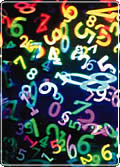 People are great at using and understanding numbers between one and ten but scientists often need to use much larger quantities.
People are great at using and understanding numbers between one and ten but scientists often need to use much larger quantities.
- The speed of light is 300,000,000 metres per second.
- The distance to the moon is 384,467 kilometres.
- There are usually between 10,000,000 and 20,000,000 sperm per millilitre of human sperm.
Big numbers like these can get confusing.
- One thousand 1,000
- One million 1,000,000
- One billion 1,000,000,000
- One trillion 1,000,000,000,000
Some of these numbers are truly huge, think about them as measures of time:
- One thousand seconds is nearly 17 minutes
- One million seconds is 11½ days
- One billion seconds is nearly 32 years
- One trillion seconds is nearly 31,710 years
Things can get worse, there are around 8,360,000,000,000,000,000,000,000 molecules in a cup of tea!
 Going to the other extreme very small numbers are used by scientists just as often.
Going to the other extreme very small numbers are used by scientists just as often.
- These marine diatoms (seen here through a microscope) range in size from ten to 150 millionths of a metre. That is from 0.00001m to 0.00015m.
- The wavelength of the blue light coming from this image is about 450 nanometres (nm) - 0.00000045m.


What's your opinion?
Average rating




Current rating: 3/5 (from 3 votes cast)